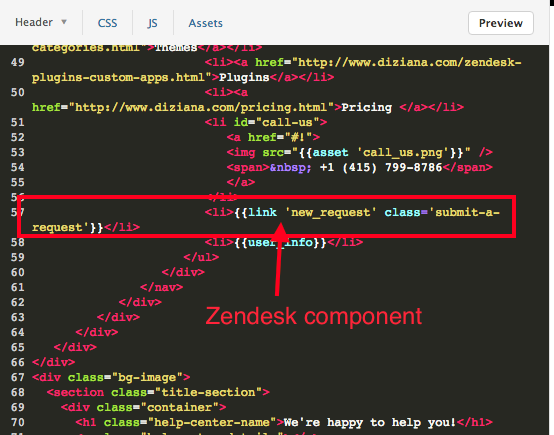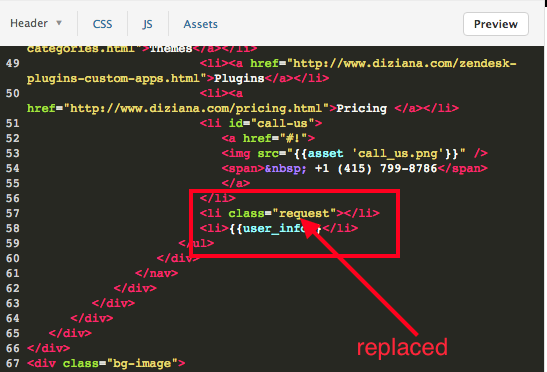Recent searches
No recent searches
Diziana
Joined Apr 15, 2021
·
Last activity Feb 04, 2022
Following
0
Follower
1
Total activity
43
Vote
1
Subscriptions
26
ACTIVITY OVERVIEW
BADGES
ARTICLES
POSTS
COMMUNITY COMMENTS
ARTICLE COMMENTS
ACTIVITY OVERVIEW
Latest activity by Diziana
Diziana created a post,
A question (Send email via Sendgrid?) made me come up with this tip. Kudos to @Pedro for asking this question.
Disclaimer:
- This tip isn't meant to be replacement of Zendesk's built-in notification system. Zendesk pre-processes (email-template, placeholders, content, signatures, etc.) to generate email-body which is sent. One can build upon following example, and try html/markdown/liquid stuff to generate richer emails.
- Please use a sandbox or test environment; or limit the scope of trigger (by making it run only in presence of a tag or requester-email that you control)
-
I am furnishing the following tip "as is". I (and Diziana) don't provide any warranty of the tip (or results) whatsoever, whether express, implied, or statutory, including, but not limited to any warranty that the contents of the tip will be error-free.
In no respect shall I (and Diziana) incur any liability for any damages, including, but limited to, direct, indirect, special, or consequential damages arising out of, resulting from, or any way connected to the use of the tip.
Objective: Send outgoing email notifications via SendGrid
Prerequisite: SendGrid Account
Part 1: Setting up HTTP Target Extension for SendGrid API
- Login as Admin in your Zendesk Support
(.zendesk.com/agent/)
- Go to Admin (Cog Icon) > Settings > Extensions
(.zendesk.com/agent/admin/extensions)
- Click on "add target"
( - Enter "SendGrid" in Title field

- Replace highlighted part in URL (below) with your SendGrid username and password.
https://api.sendgrid.com/api/mail.send.json?api_user=&api_key=
- Enter the URL (above with your SendGrid username and password) in URL field

- Select "POST" from Method dropdown

- Select "Form encoded" from Content type dropdown

- Leave "Basic Authentication" UNCHECKED

- Select "Test Target" from dropdown next to "Submit" button

- Enter keys and valid values in the form

- Click on Submit button (shown in above form) to test SendGrid Configuration
- You will see results, an HTTP 200 status for success (i.e. our SendGrid configuration is good)

- Close the Test Form Overlay Popup
- Select "Create target" and Click "Submit" to create HTTP Target

Part 2: Setting up a test Trigger to use SendGrid HTTP Extension
- Go to Admin > Business Rules > Triggers
- Clone any existing trigger by clicking Clone option for trigger. For example, we are going to clone "Notify requester of received request" trigger:


- Change Trigger Name to whatever you want to. I am going to call it "SendGridTest Trigger"

- Change Conditions of Trigger (Ticket is Updated, and Status is not Solved, and Tags contain "sendgridtest").

Note: I have added a tag in conditions to limit the scope of testing to tickets I control, and I don't triggers to run on any other updates until it's ready for production usage.
- Add "Notify Target" Action, and select "SendGrid" as target
- Enter key-values the same way you used earlier while testing HTTP Target; this time we will use placeholders instead of hardcode values:
to: {{ticket.requester.email}}
toname: {{ticket.requester.name}}
from: support@yourcompany.com
fromname: Yourcompany Support
subject: [{{ticket.account}}] Re: {{ticket.title}}
text: {{txt.email.delimiter}} Your request ({{ticket.id}}) has been updated. To add additional comments, reply to this email. {{ticket.comments_formatted}}
- Click "Create" button to create Trigger
Part 3: Testing
- Create or open a test-ticket (where you have access to requester's mailbox)
- Add "sendgridtest" tag in ticket
- Submit as "New" or "Open"
- Check requester's mailbox, and see if you received notification
I hope you it worked for you. If it didn't, please debug it, or feel free to post in this thread.
That's it for now. I think, it's good start and I am looking forward to see if someone can improve upon it -- specially email-template, and html emails.
Cheers
-abdul
==
Abdul Qabiz
diziana • twitter • linkedin • blog
Team Diziana
Visit Diziana to download free and premium custom responsive ready-to-use Zendesk theme or Zendesk template or Zendesk plugins for Zendesk Help Center. Brand your Zendesk Help Center, and provide fantastic self-service customer support experience.
Posted Sep 21, 2017 · Diziana
0
Followers
5
Votes
3
Comments
Diziana commented,
Hi David
You can use some jquery to change it on runtime. That said, please do look at documentation to see if there is a better method.
If you are interested in jquery method, please leave a comment and I would post some code snippet.
Thank you
Team Diziana
Visit Diziana to download free and premium custom responsive ready-to-use Zendesk theme or Zendesk template or Zendesk plugins for Zendesk Help Center. Brand your Zendesk Help Center, and provide fantastic self-service customer support experience.
View comment · Posted Apr 26, 2017 · Diziana
0
Followers
0
Votes
0
Comments
Diziana commented,
@Jennifer Thank you :-)
Team Diziana
Visit Diziana to download free and premium custom responsive ready-to-use Zendesk theme or Zendesk template or Zendesk plugins for Zendesk Help Center. Brand your Zendesk Help Center, and provide fantastic self-service customer support experience.
View comment · Posted Apr 18, 2017 · Diziana
0
Followers
0
Votes
0
Comments
Diziana created a post,
[Following tip was posted as comment here; we think, this tip deserves it's own post]
Prerequisite: Zendesk Professional, or onwards subscriptions plan
Question: What I am going to get out of this tip?
Answer: If you want to show a welcome note (f.ex. "Hi Tom, how can we help?") in search-box (see image below), and let's say you want that to show in multiple languages?
Tip shared below would allow you to have multilingual welcome-note in search-box.

Please follow steps below:
- Create Dynamic Content called "hc_search_greetings_template"
- Store a string like, "Hello %NAME%, how can we help you?" in in "hc_search_greetings_template"
- Add more variants (languages) but let's keep %NAME% in string where we want Name to appear"
- Add a span tag with data-* attribute (following line of code) in Header template (at the end, after line)
data-value="{{dc 'hc_search_greetings_template'}}"
style="display:none"> - Let's modify our code and place it any where in Theme JavaScript (General > Customize Design > Edit Theme > JS)
$(document).ready(function() {
if(HelpCenter.user.role!='anonymous') {
var gtext = $("span#dc_greetings_template").data('value');
gtext = gtext.replace('%NAME%', HelpCenter.user.name);
$('#query').attr('placeholder', gtext);
}
});
Please try it, and share your feedback. I hope, it helps you. Have any questions, please get in touch.
Cheers
Team Diziana
Visit Diziana to download free and premium custom responsive ready-to-use Zendesk theme or Zendesk template or Zendesk plugins for Zendesk Help Center. Brand your Zendesk Help Center, and provide fantastic self-service customer support experience.
Posted Apr 17, 2017 · Diziana
0
Followers
8
Votes
5
Comments
Diziana commented,
@Sheila: This would work on your website.
View comment · Posted Apr 05, 2017 · Diziana
0
Followers
0
Votes
0
Comments
Diziana commented,
Reading this post makes us feel bad, we missed the session.
We have been part (through our ready to go zendesk templates and themes) of so many stories where companies have happier customers because of well designed self-service experience.
In couple of years, we are going to see more focus on self-service help-center(s); thanks to advancement in machine-learning, and AI -- we are going to see more smart things in help-centers.
We would make sure we don't miss a session like this again.
Thank you
Team Diziana
View comment · Posted Mar 28, 2017 · Diziana
0
Followers
0
Votes
0
Comments
Diziana commented,
Hi Max,
Wondering if you are using default Copenhagen theme? It gives an option for voting.
Further, you can add this code in your article template:
View comment · Posted Jan 02, 2017 · Diziana
0
Followers
0
Votes
0
Comments
Diziana commented,
Hi Annastashia,
Thanks for reaching out to us. I think this should work. Did you disable the mobile layout from the HC settings?
I looked at your HC and it seems you haven't disabled the mobile layout option, please disable it.

Also on responsive you need to add the submit button on the menu (hamburger icon) as for now only sign in seems to be listing.
Please share if you have further any questions.
Looking forward hearing from you.
Cheers,
View comment · Posted Nov 07, 2016 · Diziana
0
Followers
0
Votes
0
Comments
Diziana created a post,
Zendesk note: This tip is addresses the use case where you want to hide the submit a request link until the user signs in, and not restrict tickets in all channels to sign-in users. Alternatively, you can restrict all ticket submission to signed-in users, and prompt users in the Help Center to sign in when they click submit a request (see this article).
Problem: Many organization having their HC on public URL want's the ability to have only signed-in users (end users) to have access to submit a ticket page (new request page).
Solution: Using the below code you can prompt the user to sign-in/signup in order to send a ticket. Zendesk note: Instead of using the JSS in this tip, you might consider using the signed-in helper as described in this comment and the subsequent comment.
- Login into your Help center as admin/agent
- Click customize design
- Click Edit theme
- On HTML replace the submit a request component by adding class=“request” to the element you want to wrap submit-a-request button.
- For an e.g. see how below screen


- Now go to JS and paste the below code:
(function(_w, _d, $){
$(_d).ready(function(){
var _locale = window.location.pathname.replace('/', '')
.replace('?','/').split('/')[1];
if (HelpCenter.user.role=='end_user') {
$('.request')
.html(''+
'Submit a request');
} else if (HelpCenter.user.role=='anonymous') {
$('.request')
.html(''+
'Submit a request');
}
});
}(window, document, jQuery));
- Save and publish the changes.
This would ask your non-logged in user to sign-in/sign-up if they want to submit a ticket on your public help center.
Get its touch (support@diziana.com) if you face any problem.
Cheers,
Posted Jun 30, 2016 · Diziana
0
Followers
13
Votes
11
Comments
Diziana commented,
Hi Andy,
Here is a small hack
- I am taking Wiry merchant as a reference to solve this
- Go to home page and under component pass an attribute id="{{id}}" as shown:

- Save the changes.
- Now get the ID of the category you want to hide on the home page. (You can get it from the URL)
- Go to JS and add the line as shown :
$('#200999725').hide();

- Replace the id with your category id.
- Save and publish the changes.
Hope this would work.
Let us know if you find any problem.
Cheers,
View comment · Posted Jun 24, 2016 · Diziana
0
Followers
0
Votes
0
Comments